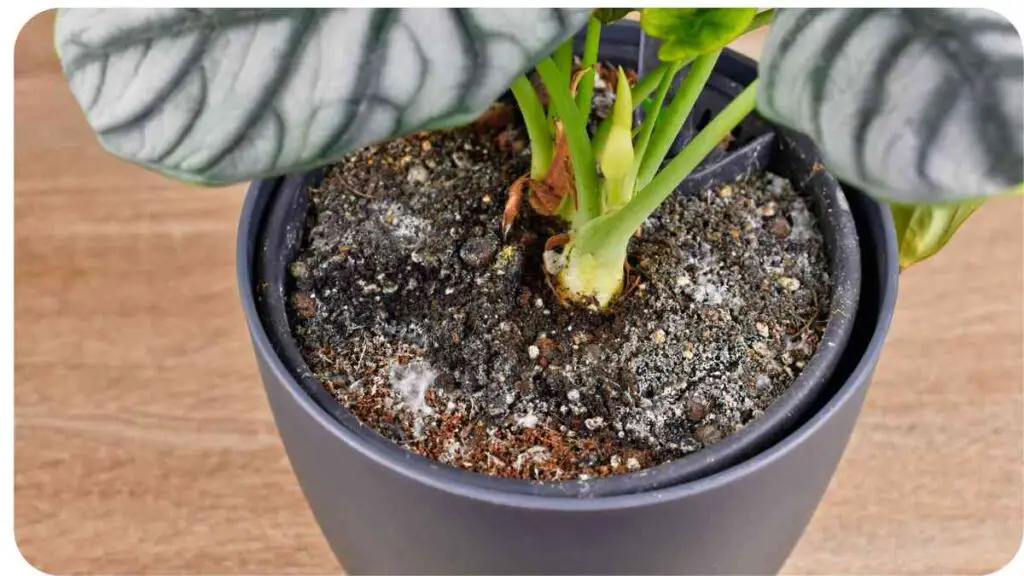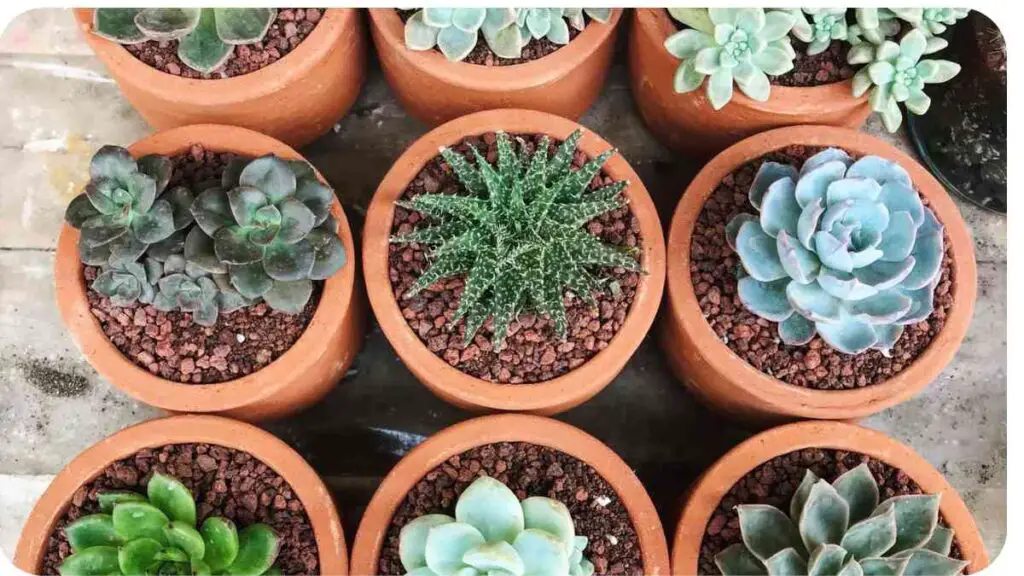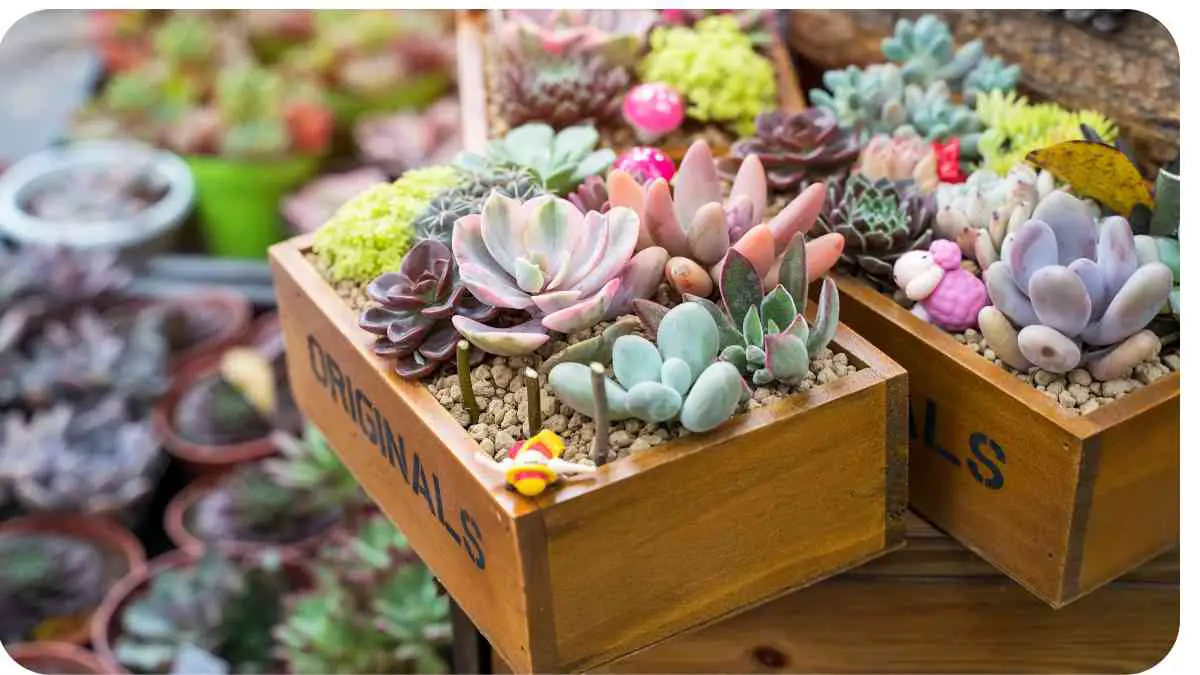Succulents have become a favorite choice for plant lovers due to their hardy nature and minimal care requirements. However, even these resilient plants can suffer from one common issue: overwatering.
While it might seem counterintuitive that these drought-tolerant plants can be overwatered, it’s a problem that many succulent enthusiasts encounter. In this guide, we’ll explore the signs of overwatered succulents and provide practical solutions to help you rescue your plants and keep them thriving.
| Key Takeaways |
|---|
| Overwatering succulents can lead to serious issues like root rot and pests. |
| Signs of overwatered succulents include wilting, mushy leaves, and root rot. |
| Immediate actions to take include assessing the situation, removing excess water, and improving drainage. |
| Long-term solutions involve adjusting watering habits, choosing the right soil, and selecting pots with proper drainage. |
| Prevent overwatering by using a soil moisture meter and understanding seasonal watering needs. |
| Avoid common mistakes such as using pots without drainage and misunderstanding watering requirements. |
| Implement expert tips like adjusting watering based on seasonal changes and learning from success stories. |
What Are Succulents?
Succulents are a group of plants that store water in their leaves, stems, or roots, allowing them to survive in arid conditions. They come in various shapes, sizes, and colors, making them popular for both indoor and outdoor settings. Their ability to retain water makes them relatively low-maintenance, but it also means that improper watering can have serious consequences.
Understanding why plants wilt despite regular watering can be perplexing. Explore The Mystery of Wilting Plants Despite Regular Watering to uncover potential causes and solutions for this common issue.
Why Overwatering is a Problem

The Basics of Succulent Water Needs
Succulents have adapted to survive with minimal water, which is why they can often go for weeks without needing a drink. Their fleshy leaves and stems act as reservoirs, storing water for times when it’s scarce. Understanding their natural watering needs is key to avoiding overwatering.
Impact of Overwatering
Overwatering can lead to several problems for succulents, primarily because their roots are not designed to handle excess moisture. Prolonged exposure to waterlogged conditions can lead to root rot, mold growth, and a host of other issues that can ultimately kill the plant.
Soggy garden beds are often a sign of poor soil drainage. Learn effective methods to address this problem in Soil Not Draining: Solutions for Soggy Garden Beds.
Signs of Overwatered Succulents

Wilting and Soft Leaves
One of the first signs that a succulent might be overwatered is wilting or soft leaves. While succulents naturally have firm, plump leaves, overwatering can cause them to become limp and mushy.
Table: Comparison of Healthy vs. Overwatered Leaves
| Feature | Healthy Leaves | Overwatered Leaves |
|---|---|---|
| Texture | Firm and Plump | Soft and Mushy |
| Color | Vibrant and Rich | Yellowing or Pale |
| Shape | Well-Defined | Drooping or Wilting |
| Moisture Level | Balanced | Excessive |
Yellowing and Mushy Leaves
If the leaves of your succulent start turning yellow and become mushy, this is a strong indicator of overwatering. The plant is struggling to cope with the excessive moisture, leading to the deterioration of its leaves.
Root Rot
Root rot is a serious issue caused by consistently soggy soil. Roots that are damaged by excess water will appear brown or black and may have a slimy texture.
Uneven lawn growth can indicate various underlying issues. Discover practical solutions for this problem by reading Troubleshooting Uneven Lawn Growth: Causes and Solutions.
Table: Root Health Indicators
| Root Color | Healthy Roots | Overwatered Roots |
|---|---|---|
| Color | White or Light Brown | Brown or Black |
| Texture | Firm and Resilient | Soft and Slimy |
| Odor | Earthy | Foul or Musty |
Pest Infestations
Overwatered succulents are more susceptible to pests like mealybugs and aphids, which thrive in damp conditions. Keep an eye out for these unwanted visitors.
Immediate Actions to Take
Assessing the Situation
Before taking any action, evaluate the extent of the damage. Check the soil moisture, inspect the leaves, and assess the roots if possible.
Removing Excess Water
If the soil is excessively wet, the first step is to remove the excess water. This might involve tipping the pot to drain out any standing water.
Improving Drainage
Good drainage is crucial for succulents. Ensure that your pot has adequate drainage holes and that the soil is well-draining.
Table: Recommended Soil Mixes for Succulents
| Soil Type | Drainage Quality | Common Ingredients |
|---|---|---|
| Cactus Mix | Excellent | Sand, Perlite, Peat Moss |
| Succulent Potting Mix | Good | Perlite, Coarse Sand, Peat |
| DIY Mix | Adjustable | Sand, Perlite, Pine Bark |
Re-potting Your Succulent
If the damage is severe, re-potting might be necessary. Choose a new pot with good drainage and fresh, well-draining soil.
Lawn thatch build-up can affect your lawn’s health. Find out how to manage this issue in Understanding Lawn Thatch Build-Up and How to Address It.
Long-Term Solutions
Adjusting Watering Habits
To prevent future issues, adjust your watering habits. Allow the soil to dry out completely between waterings, and avoid watering on a set schedule.
Choosing the Right Soil
Selecting a soil mix specifically designed for succulents can make a big difference. Ensure it has good drainage properties and is free of heavy, moisture-retentive materials.
Selecting the Proper Pot
Use pots with drainage holes to prevent water from accumulating at the bottom. Avoid using decorative pots without drainage or saucers that hold excess water.
Regular Maintenance
Regularly check your succulents for signs of stress and adjust your care routine as needed. Keeping an eye on the plant’s condition will help you catch any issues early.
Vertical gardens can present unique challenges. Address common problems effectively by consulting Common Challenges with Vertical Gardens and How to Fix Them.
Preventing Overwatering in the Future
Best Practices for Watering
Learn and apply best practices for watering your succulents. Water deeply but infrequently, and always ensure that the soil has dried out before the next watering.
Monitoring Soil Moisture
Invest in a soil moisture meter to keep track of the soil’s moisture level. This tool can help you avoid overwatering by giving you an accurate reading.
Seasonal Care Tips
Succulents may need different care depending on the season. During winter, they require less frequent watering due to lower light levels and cooler temperatures.
Common Mistakes to Avoid
Misunderstanding Watering Needs
Many succulent owners misunderstand the watering needs of their plants. Remember, succulents prefer dry conditions and can suffer from too much water.
Using Non-Drainage Pots
Avoid using pots without drainage holes. Waterlogged soil is a common cause of root rot and other issues in succulents.
Ignoring Symptoms
Ignoring the signs of overwatering can lead to severe damage. Regularly inspect your plants and act quickly if you notice any symptoms of stress.
Expert Tips and Tricks
Advice from Succulent Enthusiasts
Succulent enthusiasts often share their best practices and tips for keeping these plants healthy. For instance, Jenna Smith, a renowned succulent grower, emphasizes the importance of adjusting watering based on seasonal changes.
Success Stories
Many gardeners have successfully rescued their overwatered succulents by following proper care guidelines. For example, Mark Johnson managed to revive his once-dying succulents by re-potting them and improving soil drainage.
FAQs
- How often should I water my succulents?
- Water your succulents only when the soil is completely dry. This typically means watering every 1-2 weeks, but it can vary based on the plant and environment.
- What should I do if my succulent leaves are turning brown?
- Brown leaves can be a sign of overwatering or underwatering. Check the soil moisture and adjust your watering accordingly.
- Can succulents recover from root rot?
- Yes, succulents can recover from root rot if caught early. Remove the damaged roots, re-pot the plant in fresh soil, and adjust your watering habits.
- What is the best soil for succulents?
- Use a well-draining soil mix specifically designed for succulents. A mix of sand, perlite, and peat moss works well.
- How can I tell if my succulent is getting too much sun?
- Signs of too much sun include sunburned leaves with brown or white patches. Provide some shade or move the plant to a less sunny location.
Conclusion
Rescuing overwatered succulents requires quick action and proper care. By understanding the signs of overwatering and implementing the right solutions, you can restore your succulents to health and prevent future issues. With these tips and tricks, you’ll be well on your way to keeping your succulents happy and thriving.
Further Reading
How to Save Overwatered Succulents
This article provides practical steps and detailed instructions on rescuing overwatered succulents. It covers diagnosis, immediate actions, and long-term care strategies to restore your plants to health.
How to Rescue Overwatered Plants
BrightView’s guide offers insights into rescuing overwatered plants, including succulents. It focuses on the importance of proper watering practices and effective techniques to improve plant health.
Signs of Overwatered Succulent and How to Fix Them
This resource details the signs of overwatered succulents and provides solutions for each issue. It includes visual guides to help identify problems and remedies for restoring succulent health.
FAQs
What are the signs that my succulent is overwatered?
Signs include wilting, yellowing or mushy leaves, root rot, and pest infestations. Overwatered succulents often have soft, limp leaves and may show discoloration.
How can I fix overwatered succulents?
To fix overwatered succulents, start by removing excess water from the soil, improve drainage, and re-pot the plant if necessary. Allow the soil to dry out completely before watering again.
How often should I water my succulents to avoid overwatering?
Water succulents only when the soil is completely dry. This usually means watering every 1-2 weeks, depending on environmental conditions and the plant’s needs.
What type of soil is best for succulents?
Use a well-draining soil mix specifically designed for succulents. A good mix typically includes sand, perlite, and peat moss to ensure proper drainage and prevent waterlogging.
Can succulents recover from overwatering?
Yes, succulents can recover from overwatering if the damage is not too severe. By addressing the overwatering issue and providing proper care, many succulents can bounce back and thrive.

Hi! My name is Hellen James, and I’m a landscape designer in Los Angeles. I’ve been working with homeowners and businesses to help them improve the look of their properties for over 10 years.

